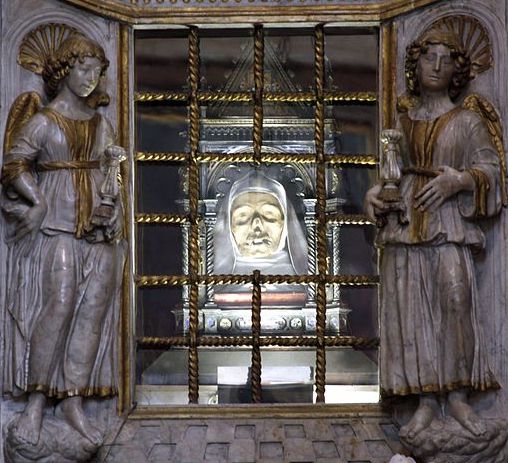by Linda Ryan
It seems like, listening to the stories of some of the lives of the saints, some of them seem to have been born to be a saint. Take Catherine of Siena. She was one of a large family home it’s reported that there were 25 children in all and she was probably number 25). By the time she had barely reached what we would consider school-age, she was having visions of Christ and his saints. It seemed she’d rather meditate than play with dolls or play childish games. By the age of 16, she joined what was known as the third order of St. Dominic, even though her parents still did not like the idea.
By the time of her death in 1380, she had expanded her world considerably. She was considered to be extremely wise and full of insight, and people came to her with questions and searching for answers, answers what she could guide them to finding. She was also quite a diplomat, working to resolve a schism between the two popes that were claiming papal power at the time, one in Avignon, France, and the other in Rome. She did not fully succeed in healing the breach between the two popes, but she was much admired for her tenacity and diplomacy. She was also a prolific writer, leaving us with over 400 letters.
Wise and saintly people have always been admired and revered, and their possessions, sometimes even parts of their bodies, were often kept in places of honor. They became objects of veneration and places where the sick and hopeless went to beg the specific saint for intervention on their behalf. When Catherine died, the Sienese were afraid that Rome was going to keep her and so they quietly snuck in, removed her head and thumb, and took them back to Siena to St. Dominic’s Church, while her remaining remains remained in Rome. If you go to the church in Siena you will find in a beautiful case the mummified head of Catherine of Siena, and not too far away from that, you will find a reliquary containing her thumb, also mummified. In addition, we have over 400 letters and her book, the Dialog of St Catherine, also known as the Book of Divine Doctrine. It is a classic mystical work, favorably compared to Dante’s Divine Comedy as representative of the attempt to express the Divine in symbols of that era.
“Relic” is a word with several definitions, but for the most part, it is defined as something from an earlier time that has some historical or sentimental value, like Catherine’s head or the Shroud of Turin, George Washington’s false teeth (although rather less revered as a religious icon) or the Dead Sea Scrolls.
It seems kind of barbaric to have pieces of people placed up in a place of prominence where they can be adored and used as foci for prayers and requests. Some of them are pretty gruesome. Even in our own time we still respect and revere relics, not only of saints but also other things, like memorials to famous people, their clothing or jewels, or homes or articles associated with them. But then, we flock to museums to see the mummies of ancient Egyptians, bog people, or dinosaur bones.
It seems like were learning to make our own relics. The Declaration of Independence is a relic, as are the bowls and baskets unearthed from Native American homesites like the cliff dwellings in Mesa Verde, Arizona. We learn from ancient artifacts, most of them outmoded, but some surprisingly useful even in modern times. We have the flag flown at Fort McHenry which inspired Francis Scott Key to write the lyrics to our national anthem. We have rebuilt slave quarters to remind us of our enslavement of people of color for generations. In our churches we use a sort of outmoded technology to create images and representations in stained glass of everything from images of the early saints and martyrs to the window containing a moon rock at the National Cathedral.
Relics are things which beg to be pondered. They ask us to consider what these objects, images, and artifacts meant to those who created and used them, and then what relevance they have for us today. What do they teach us? Of what do they remind us? What do they call us to do? We’re used to thinking of the Bible (itself a relic) in those terms, but there are other things as well. And we can find glimpses of God in many of them, if we but look.
I may never get to Siena, but I have seen pictures of Catherine of Siena’s head, and I can see why people would revere it. It brings her close to us today even though she lived hundreds of years ago. She is a reminder of how a simple person, simple in the sense of plain living but great service to others, can make a big difference in the world. Maybe we need a few more relics to remind us of that. Who knows? We might learn some lessons that we should have learned long ago.
God bless.
Linda Ryan co-mentors 2 EfM Online groups and keeps the blog Jericho’s Daughter. She lives in the Diocese of Arizona and is proud to be part of the Church of the Nativity in North Scottsdale.
Image: José Luiz Bernardes Ribeiro / head of St Catherine , via Wikimedia Commons

